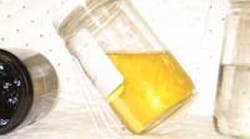GELLED, USED AND NEW HEAT-TRANSFER FLUID
Figure 2. If a cooled sample won't pour, don't shut down your system until you have a plan to remove and replace the fluid.
Myth 4 — Never operate a thermal fluid above its autoignition temperature (AIT). Autoignition (spontaneous ignition) is the most frightening potential source of fire because all you theoretically need is temperature and a leak to turn the heater room into a furnace. As long as the fluid temperature stays below the stated AIT, so the myth goes, the risk of fire is minimal. The truth actually is pretty simple. With the exception of most vapor-phase products, a few high-temperature aromatic-based liquids and many low-temperature non-aqueous fluids, most thermal fluids don't have a true AIT. The current standard test method, "Autoignition Temperature of Liquid Chemicals" (ASTM E 659-78), involves injecting 100 microliters of liquid into a heated 500-ml flask. If no ignition of the sample is observed within 10 minutes, the temperature of the flask is raised and another sample is injected. The critical piece of information regarding this test appears in the "Significance and Use" section (5.5): "This test method is not designed to measure the autoignition temperature of materials which are solids or liquids at the test temperature (for example, wood, paper, cotton, plastics, and high-boiling-point chemicals). Such materials will thermally degrade in the flask and the accumulated degradation products may ignite." Because most liquid-phase thermal fluids have boiling points (i.e., vapor pressure exceeds 14.7 psia) above 690ºF, any reported AIT less than the boiling point is by definition not a true AIT.Fluids can and do spontaneously ignite, though. Insulation fires can result from spontaneous ignition, as can some pump fires. However, the material that ignites isn't the original thermal fluid but fluid that's been exposed to air for an extended time. In porous insulation such as fiberglass, rock wool or perlite, the fluid wicks away from the leak point, leaving a thin film through the insulation. The limited supply of air and constant high temperature from the pipe cause the fluid to decompose. Eventually the decomposition products reach their AITs and ignite. Use of nonporous insulation or judicious use of porous insulation can prevent these fires. Leaked fluid that pools under a pump or some other uninsulated piece of equipment can undergo a similar decomposition. The most effective way of preventing these pool fires is to ensure any leaked fluid drains away from the hot equipment.
Myth 5 — My flash point has fallen so I can't start up. This myth is widely repeated by corporate safety departments and rogue insurance representatives. It assumes that operating a thermal fluid above its flash point will result in an immediate and thoroughly destructive fire if the fluid leaks out. Actually liquid heated above its flash point produces combustible vapor and the "flash" ends as soon as the vapor has been consumed. For a thermal fluid to burn, it must remain hot enough to continuously generate vapor. Because liquid-phase thermal fluid systems operate under moderate pressure — typically a maximum of 100 psig at the circulation pump discharge — a leak will result in a fluid discharge into the surrounding area. Most thermal fluids have a flash point between 300°F and 450°F (some have a flashpoint as high as 530ºF but their high viscosity limits their usefulness) and can't produce ignitable vapors below 300°F. So unless a combustion event (like a fire) already is in progress around the leak, even a heater room in Arizona in August is cool enough to reduce the temperature of the leaking fluid rapidly below its vapor region.The potential for vapor ignition becomes the most problematic when either the air volume is small or the leak volume is large. In enclosed areas such as ovens with limited air to cool and react with the vapor, even small leaks can pose risks. What often misleads investigators is that fires in these confined spaces can result from autoignition caused by the partial degradation of the leaked fluid. Large leaks become a problem when the quantity of vapor released overwhelms the capacity of the ventilation available to cool the leaked fluid as well as react with the vapor. If the vapor cloud, which resembles gasoline vapors in appearance, gets large enough, it may eventually reach an ignition source. So why don't insurance companies, international fire codes or government regulators prohibit thermal fluids? The truth is that one of the requirements for a fire — air — actually can prevent these fires from occurring. As most users know, the telltale sign of a thermal fluid leak is smoke. Smoke is the visible byproduct of the hot (>300°F) thermal fluid vapor reacting with air. Good ventilation not only cools the fluid so vapor no longer is produced but also increases the quantity of vapor that can be safely converted without an actual fire. While no current specifications exist for "good ventilation," a useful rule of thumb for a heater room is that room temperature shouldn't exceed ambient temperature by more than 40°F.
DON'T BE MISLEDThe common thread through these myths is that thermal fluid systems are mysterious and unpredictable and, as a result, potentially dangerous. Like any myths, these can be debunked with an understanding of what really causes the problems and, more importantly, how to prevent them.
JIM OETINGER is technical director of Paratherm, West Conshohocken, Pa. E-mail him at [email protected].




